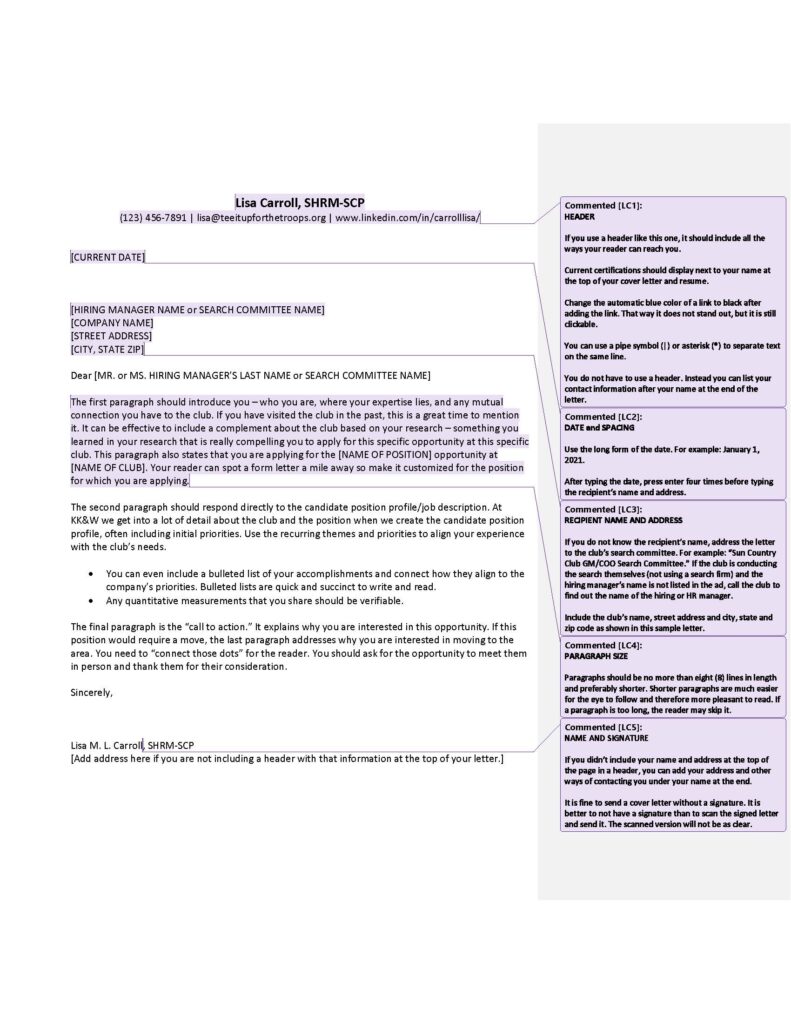By Lisa Carroll, SHRM-SCP
The cover letter is one of the most important letters you will ever write. A prospective employer will decide whether they want to meet you based on your resume and cover letter. The resume holds the relevant data (job history, accomplishments, education, etc.), but the cover letter connects the dots and “sets the hook” to help secure that all-important first interview. Here are a few tips to give your cover letter the impact it needs to connect with a prospective employer.
HEADER (Optional)
– Include all the ways a potential employer can reach you if you use a header like the one in the sample letter below, for example: email, phone number(s), LinkedIn profile, etc. Have it match the header of your resume.
– Place any current certifications next to your name.
– Change the automatic blue color of a link to black after adding the link. That way it does not stand out, but it is still clickable.
– Use a pipe symbol (|) or asterisk (*) to separate text on the same line.
– You do not have to use a header. Instead, you can list your contact information after your name at the end of the letter.
LENGTH & PAGE 2 HEADER
If your cover letter is long enough for a second page (no longer than two pages, please!), insert a header (use Microsoft Word) on page 2 that lists the recipient’s name, the long form of the date, and the page number.
DATE AND SPACING
– Use the long form of the date. For example: January 1, 2024.
– After typing the date, press enter four times before typing the recipient’s name and address.
RECIPIENT NAME AND ADDRESS
– If you do not know the recipient’s name, address the letter to the company’s HR department. For example: “ABC Company HR Department.” If the company is conducting the search themselves (not using a search firm) and the hiring manager’s name is not listed in the ad, call the company to find out the name of the hiring or HR manager.
– Include the company’s name, street address, city, state, and zip code as shown in the sample letter below.
PARAGRAPHS
Paragraphs should be no more than eight (8) lines in length and preferably shorter. Shorter paragraphs are easier for the eye to follow and therefore more pleasant to read. If a paragraph is too long, the reader may skip it.
– 1st Paragraph: Introduce yourself and your expertise, and state exactly which position you are applying for and why.
– 2nd Paragraph: Respond directly to the job posting description by aligning your experience with the company’s needs as expressed in their job listing.
– 3rd Paragraph: Explain why you are interested in the position and location. If there is another compelling reason to move for the job (you have relatives or in-laws or friends in the area), be sure to list that additional draw to the area. Also ask for the opportunity to meet with them and thank them for their consideration.
See the sample cover letter below for more details on paragraph content.
NAME AND SIGNATURE
– If you didn’t include your name and address at the top of the page in a header, you can add your address and other ways of contacting you under your name at the end of the letter.
– It is fine to email or upload a cover letter without a signature. It is better to not have a signature than to scan the signed letter and send it. The scanned version will not be as clear.
SAMPLE COVER LETTER

Lisa Carroll, SHRM-SCP, is a former search executive and has conducted numerous general manager, executive chef, assistant general manager, clubhouse manager, and chief financial officer searches in the private country club industry. She currently serves as a volunteer ambassador for Tee It Up for the Troops based in Burnsville, Minnesota (teeitupforthetroops.org/).
